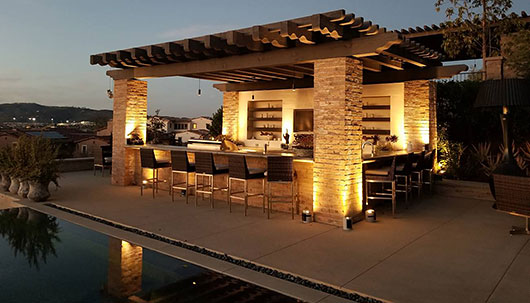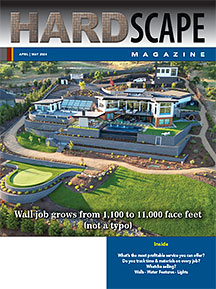Articles written by guest contributors

Demo doubles lighting sales
Being skilled in effective outdoor lighting doesn’t matter if you can’t sell it.
By Nate MullenWe’ve seen a boom the last 10 or 15 years in patios, fire pits, barbecues, cabanas, pools, structures, walls, etc. But everybody dismisses lighting.
Homeowners cut the lighting budget saying, "We don't need very many lights. I just want 5 path lights there and a light on each of those trees. I don't want any on the house. And, let me see a catalog." The contractor says, "Here's a catalog, absolutely, whatever you want."
Most lighting jobs look terrible because homeowners are designing them. They’re designing them based on their neighbor’s outdoor lighting which the neighbor designed without any expertise.
The contractor goes with what the customer specifies because he doesn’t know how to sell lights. I do not believe any design plan is going to sell a professional lighting job. People can’t comprehend what those dots on a plan will actually look like.
A good demo puts real lights in real locations to visually show people how the lights are going to transform their yard. They have to experience how it will look to understand that it’s going to take a lot more fixtures to do it right and make it look good.
Look at it as if you’re an attorney. Your competition is a competing attorney, and you're going head on. The homeowner is the judge. You want to start out by putting your most compelling evidence forward to immediately sway the judge. Doing a demo at night on location is absolutely your most compelling evidence.
The demo turns a 20-light job to a 40-light job. It turns a 30-light job to a 60-light job. It’s almost impossible to sell 50 or 100 lights without a demo.
LED battery lights make demoing easy
In the past, not many contractors did lighting demos because setting it up was a time-consuming ordeal. You had to set up transformers and extension cords, and run wires to every fixture. Today’s battery-operated LEDs turn what used to be a 2-hour job into a 15-minute job. I can set up 30 lights in literally 15 minutes. LEDs need only 3 or 4 watts each so batteries can light them up to the same brightness as electricity. What you see is what you will get.
You can buy battery-powered fixtures or make them yourself. I take 8 AA batteries (makes 12 volts), put them in a battery pack and connect them to a fixture.
How to do the demo
In the demo, you strategically place lights on the property to convey the effects you recommend for that property. If you visualize it as a 100-light job, you’re probably going to put 40 lights out for the demo. If it's a 30-light job, you might put 15 or 20 out there.Then the homeowner comes out and says, "Oh my God, that's absolutely beautiful." And they might ask, "How many lights is that?" I reply, “I'm not exactly sure, maybe 20 or 30. It took what it took. Consider this: When we were inside the house, I noticed that you had a couple paintings on the wall. Now, when you bought the paintings, did you ask the painter how many tubes of paint it took to paint the painting?"
They say, "Well, of course not, that's silly." I reply, "Exactly, because you bought the finished effect. That’s what I do. I don't sell lights. I sell a finished effect, lighting portraits. I sell something that you look at every night and you enjoy it. It's visually attractive, and it invites you outside. So in accomplishing these things, does it matter how many lights it took to achieve them?"
Most will then agree that the number of lights doesn’t matter. Now, I've removed that objection, and that's key.
Educating the homeowner
Once the demo is set up, I give the homeowner a laser pointer and say, "Now I want you to take the laser pointer and point to any 4 lights, and I'll turn them upside down." And when I do, they say something like, "Oh, that doesn't look as good. Put them back up."I'll tell them, “If I were to light your property with 15 or 20 fixtures I’ll only have enough to put 1 front-light on each tree (which is what everyone does).” So I show them and they can see it’s just not attractive compared to when I put 2 or 3 behind it and to the side.
These things help them start to understand fixture placement and how many fixtures it takes to achieve what I'm trying to do. Going thru this process around the property we figure out that it will take 50 or however many lights to complete the job.
You want lighting critics
To reinforce the difference between good lighting and bad, I ask the homeowner to look around at their neighbor’s outdoor lighting. I want to make them a lighting critic. “Does that job over there look good?” “Nope.” “How about that job over there?” “No, because they didn't light the house.” Or, “No, they only put 1 light on a tree.” Now that they’re educated, they’re ready to critique my competition. I suggest they get some other bids, and require that bidders also do a demo.
I do this because my competition is going to tell them that they can do the job with 15 or 20 fixtures. And, when they set them up in a demo, I will win every single time assuming the homeowner can afford the 50 lights. I will win because I have compelling evidence.
With more than 30 years as a landscape lighting artist and manufacturer, Nate Mullen has installed or touched over 80,000 lights. He’s published 4 books on marketing, selling, designing and installing landscape lighting. Nate is the founder of Unique Lighting Systems (sold to Toro in 2011) and currently the owner/founder of Lifetime Lighting Systems. Call (760) 304-8183 or visit LifetimeLightingSystems.com













